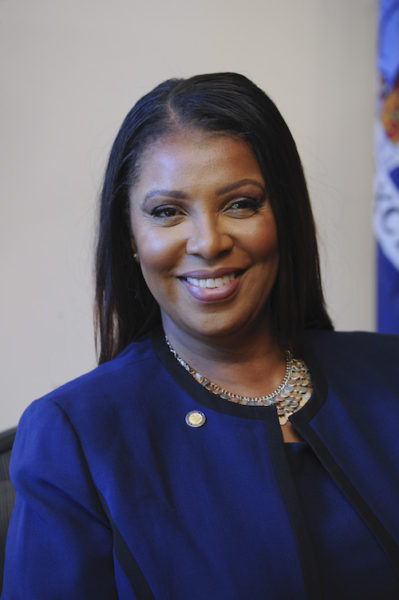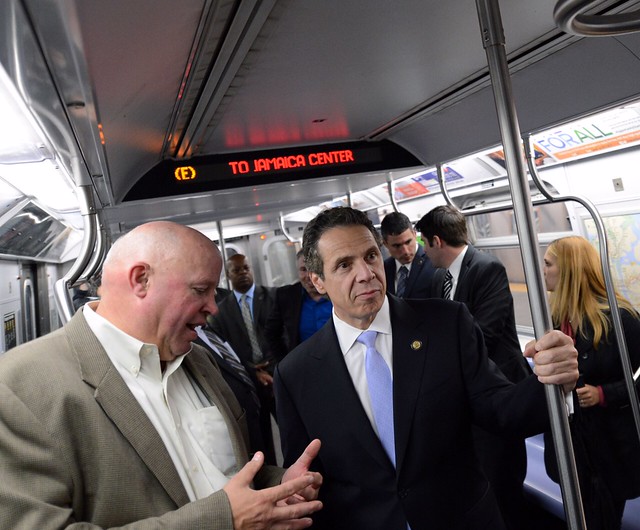
After a year of debate about cops in the subway, NY Attorney General Letitia James is investigating NYPD fare evasion enforcement.
Following a year of increased attention focused on the way the NYPD and MTA police patrol the subways, New York State Attorney General Leticia James announced an investigation into those policing practices last week. James said her office will examine whether the NYPD had been specifically targeting New York City’s “communities of color through its enforcement of the ‘theft of services’ law and the Metropolitan Transit Authority’s (MTA) ‘fare evasion’ regulations,” according to a release her office sent out.
“We’ve all read the stories and seen the disturbing videos of men, women, and children being harassed, dragged away, and arrested by officers in our city’s subway system, which is why we are launching an investigation into this deeply troublesome conduct,” James said in a statement. “If groups of New Yorkers have been unfairly targeted because of the color of their skin, my office will not hesitate to take legal action. While we are hopeful that the NYPD will cooperate thoroughly with this investigation, we will not hesitate to use every investigative tool at our disposal to protect subway riders and the people of this city.”
James’ investigation caps off a year of an increased focus on the role of policing in the subway systems as the MTA Board grappled with a call by politicians to add 500 more cops to the subways and buses. Last fall, I examined the shifting rationale and tense debate, and in late December, the MTA Board approved the budget that included funding for the additional police. These officers will fall under the MTA umbrella, and not the NYPD, but this is a distinction lost on all but the most attuned New Yorkers. Thus, while MTA sources tell me they feel MTA officers will be more accountable and better managed by the transit agency, community activists fear that state (rather than city) oversight and a lack of body cameras on the officers will lead to different kinds of abuses.
With this discussion looming large, James’ office’s involvement also grew out of a recent New York Times article that explored how NYPD claimed in sworn affidavits that they had been pressured to target minority groups for low-level violations in the subway. Although NYPD officers claim they stopped this practice, James alleges otherwise. “Newly-published data indicates that this alleged policy may still continue today,” her office noted. “Between October 2017 and June 2019, black and Hispanic New Yorkers received almost 70-percent of all civil summonses for fare evasion, even though they only account for slightly more than half of the city’s population. During that same period, they made up nearly 90-percent of arrests for fare evasion.”
In announcing the investigation, James also released a letter she sent to the new police commissioner Dermot Shea asking for data the NYPD was supposed to make public [pdf]. Among other things, the letter requests accounting for all officers assigned to the subway, records and agreements with the MTA on fare evasion enforcement and detailed demographics break downs on fare evasion summonses and arrests. This is information the MTA Board has long requested of the NYPD and information the NYPD has been reluctant to release. James expects all documents by February 10.
The Attorney General’s press release contains a veritable who’s-who of New York politicians angling for higher office expressing support for the investigation. Scott Stringer, Corey Johnson and Eric Adams, all potential contenders in the 2021 mayoral race, lent their voices to the release, as did Public Advocate Jumaane Williams and State Senators Alessandra Biaggi and Julie Salazar. (Adams, though, seems to want to have his cake and eat it too as the former cop-turned-Brooklyn Borough President recently endorsed the decision to add 500 additional officers to the 2500 who already patrol the subways.)
Sources within the MTA have told me they welcome James’ intervention and that it does not undercut the argument for hiring more officers. The MTA has, as I mentioned, long pressed the NYPD to provide more detailed accounting of their fare enforcement activities, but as with many city-state divides, the local cops have resisted these requests. As the 500 new cops will be MTA officers, MTA sources feel they can better manage deployment practices and enforcement without being beholden to NYPD practices. As focus has shifted from fare evasion to misdemeanor numbers, some MTA officials are hoping the new officers will focus on stations and trains rather than simply congregating en masse at fare control. Whether this type of cultural shift can happen effectively will be something to watch as hiring increases over the next few weeks and months.

